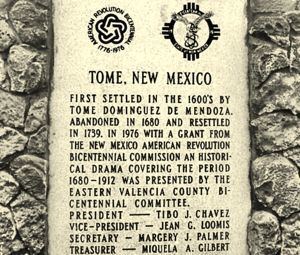Died After 1692unknown | Name Tome de | |
 | ||
Preceded by Diego Dionisio de Penalosa Briceno y Berdugo Profession Soldier and administrator (Governor of New Mexico) | ||
Succeeded by Juan Duran de Miranda | ||
Tomé Domínguez de Mendoza (1623 - After 1692) was a Spanish soldier (native of modern Mexico) who served as acting Governor of New Mexico in 1664.
Contents
Biography
Tomé Domínguez de Mendoza was born in 1626, in Mexico City. His father was a Spanish officer with the same name, a former wine merchant in Mexico City who arrived in New Mexico with his wife and at least 7 children in the mid-1630s. Tomé (II) had at least two siblings (including the soldier Juan Dominguez de Mendoza).
Mendoza joined the Spanish Army in his youth. Before 1662, he lived below Isleta Pueblo, New Mexico.
When Mendoza arrived in New Mexico, a faction led by him accused and "filed grave charges" against the governor of the province (at this time New Mexico was a province) Juan Durán de Miranda, which caused a brief imprisonment and the seizure of all his goods.
Tomé Domínguez de Mendoza was appointed Acting Governor of Santa Fe de Nuevo México in 1664. However, his government only lasted until Durán de Miranda (who was released from prison when he presented his arguments about the charges issued against him in Mexico City) recovered his government in the province a year later.
In August 1680, Tomé and his family moved to El Paso del Norte (Ciudad Juarez, in modern Mexico), along with other residents of Rio Abajo, New Mexico. There, he held several positions. One of the positions he occupied was Maeses de Campo "with full complement of arms."
In 1681, Mendoza, at sixty-one years old, died from gout and a stomach disease.
Personal life
Mendoza married twice: his first marriage was to Catalina López Mederos, with whom he had 6 children: Tome III, Antonio, Juana, Francisco (who died in the war against the Puebloans), Juan and Diego (both were injured in the same war) Domínguez de Mendoza. The second was with Ana Velásquez, with whom he had two additional children: José and Juana Domínguez.
About 1659, Governor Bernardo López de Mendizábal gave Mendoza an encomienda to the south of Isleta. When the encomienda passed into his hands, so too did the Native American population who resided there. Mendoza took advantage of this to Christianize them and make them work for him as a way of "partial compensation" for the debts he owed to the Spanish Crown for several services that the crown provided to him (i.e. protection).
In Isleta, the Dominguez family settled to the west of El Cerro de Tomé, near Tome Hill (next to Rio Grande). However, when the Pueblo Revolt broke out in 1680, thirty-eight members of the Dominguez family were attacked and killed by the Pueblo Native Americans. In addition to his four sons who fought in the Pueblo Revolt of 1680 (among them Tome III), his other two sons, Juan and Diego, were seriously injured due to poisoned arrows. Other family members, such as grandchildren, son-in-laws, brothers and nephews may have also been killed in the war.
For the most part, those who survived were forced to leave the place, emigrating south to El Paso del Norte (modern Ciudad Juarez, North of modern Mexico). So, in 1682, Don Pedro de Tomé y Chaves (brother of the first wife of Mendoza, Catalina López Mederos) got permission to migrate to modern-day Mexico with his family and the family of Mendoza. They never returned to New Mexico, even after the Spanish resettlement in New Mexico, which occurred in 1662. Thanks to the Peace Treaty between the Puebloans and the Spanish, Mendoza emigrated to Spain also never to return to New Mexico.
Legacy
The village of Tomé was built in the place where he resided, after being named as Tomé Domínguez de Mendoza.
